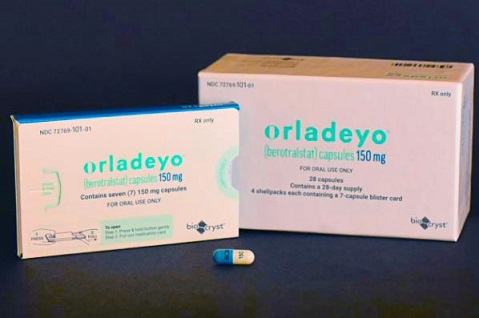New hope for glioblastoma treatment - Orladeyo shows promise in reducing cerebral edema
Nikhil Prasad Fact checked by:Thailand Medical News Team Jul 25, 2024 8 months, 2 weeks, 4 days, 23 hours, 5 minutes ago
Med News: Glioblastoma, a highly aggressive brain tumor, remains one of the most challenging cancers to treat. Traditional therapies often fail due to the tumor's ability to invade surrounding brain tissue. However, a recent study suggests a new approach that could change the landscape of glioblastoma treatment. Researchers from the IIAIGC Study Center in Burlington, VT, USA, propose repurposing Orladeyo (Berotralstat), a drug initially approved for hereditary angioedema, as an adjunct treatment to reduce brain edema in glioblastoma patients. This
Med News report delves into the study's findings and their potential impact on glioblastoma treatment.
 New hope for glioblastoma treatment - Orladeyo shows promise in reducing cerebral edema
Understanding Glioblastoma and Brain Edema
New hope for glioblastoma treatment - Orladeyo shows promise in reducing cerebral edema
Understanding Glioblastoma and Brain Edema
Glioblastoma is notorious for its rapid growth and invasive nature. One of the primary reasons current treatments are often unsuccessful is the tumor's early centrifugal migration into uninvolved brain tissue. This invasive behavior is partly driven by bradykinin, a peptide that promotes cell migration and proliferation.
Bradykinin also plays a significant role in the development of peritumoral brain edema, a common complication in glioblastoma. This edema not only exacerbates symptoms but also necessitates the use of corticosteroids like dexamethasone, which can shorten survival due to their immunosuppressive effects.
The Promise of Orladeyo or Berotralstat
Berotralstat, marketed under the brand name Orladeyo™, is an oral plasma kallikrein inhibitor approved for hereditary angioedema. Researchers believe it can be repurposed to inhibit bradykinin production at glioblastoma sites, thus reducing both tumor migration and edema.
Key Findings from the Study
-Inhibition of Tumor Migration and Growth: Bradykinin triggers various signaling pathways that promote glioblastoma cell migration and growth. By inhibiting bradykinin, berotralstat can potentially halt these processes, limiting the tumor's ability to invade surrounding tissues.
-Reduction of Brain Edema: Peritumoral edema is largely driven by bradykinin. By reducing bradykinin levels, berotralstat can decrease edema, which may reduce the need for corticosteroids and their associated negative effects.
-Improvement in Quality of Life: With less edema, patients might experience fewer symptoms and complications, potentially leading to an improved quality of life.
Mechanism of Action
Berotralstat works by inhibiting plasma kallikrein, an enzyme involved in bradykinin production. This inhibition occurs at several levels:
-Blocking Bradykinin Production: By preventing plasma kallikrein from cleaving its precursor, high molecular weight kininogen, berotralstat reduces bradykinin levels.
&
lt;strong>-Disrupting the Bradykinin Feedback Loop: Bradykinin signaling can amplify its own production through feedback loops. Berotralstat helps break this cycle, further lowering bradykinin levels.
-Reducing Blood-Brain Barrier Leakage: Bradykinin increases the permeability of the blood-brain barrier, leading to edema. By inhibiting bradykinin, berotralstat helps maintain the integrity of this barrier.
Safety and Efficacy
Clinical trials for berotralstat in hereditary angioedema have shown it to be safe with minor side effects such as nausea, diarrhea, headache, and occasional liver enzyme elevations. Importantly, there have been no reports of delayed wound healing or immunosuppression, making it a viable candidate for long-term use in glioblastoma patients.
Potential Adjunct Therapies
Researchers suggest that combining berotralstat with other drugs could enhance its efficacy. For instance, the addition of celecoxib, a COX-2 inhibitor, and dapsone, which inhibits neutrophil migration, might further reduce edema and improve outcomes.
Study Conclusions
The study concludes that berotralstat has significant potential as an adjunct therapy for glioblastoma. By reducing bradykinin levels, it can inhibit tumor growth and migration, decrease brain edema, and potentially extend patient survival by reducing the need for corticosteroids.
Future Directions
A pilot study is being planned to evaluate the efficacy of daily oral berotralstat during the chemoirradiation phase of glioblastoma treatment. The primary goal is to reduce the need for dexamethasone and the incidence of peritumoral edema. Secondary endpoints will include delayed disease progression and prolonged survival.
The study findings were published in the peer-reviewed journal: Neuroglia.
https://www.mdpi.com/2571-6980/5/3/16
For the latest
Med News, keep on logging to Thailand Medical News.
Read Also:
https://www.thailandmedical.news/news/a-new-promising-treatment-protocol-for-aggressive-type-of-malignant-brain-tumor
https://www.thailandmedical.news/news/university-of-mississippi-study-shows-that-juice-of-the-cornelian-cherry-can-help-with-glioblastoma
